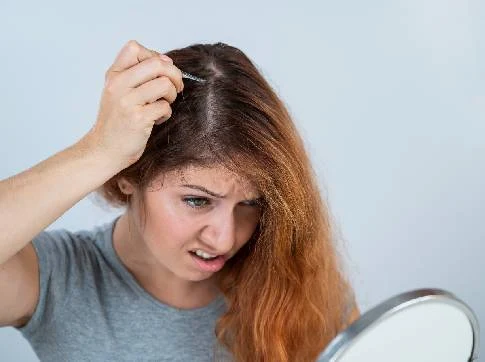How Q-Switched Lasers Are Used For Tattoo Removal
04 Apr 2024 Posted By Skinlogics
Q-switched laser is a versatile, non-ablative, medical-grade laser used by cosmetic dermatologists to improve skin imperfections. It emits a powerful laser beam capable of deep penetrating the skin without causing any damage or scarring to the superficial skin. There are two categories of Q-switched laser devices: Active and Passive, both generating different pulses of light energy. Q-switched lasers can be of different types, including Nd: YAG, Ruby, and Alexandrite.
In this blog, a Dermatologist at Skinlogics Clinic has shared all about tattoo removal in Noida with a Q-switched laser. You can also watch this video by our expert to learn more about safe, unwanted tattoo removal with lasers-
Uses of Q-switched Laser
Q-switched lasers serve many purposes in cosmetic dermatology, including:
- Skin resurfacing to improve skin texture and tone, reduce wrinkles, and decrease sebum production
- Pigmentation removal to clear skin off pigmented skin lesions or vein (vascular) lesions, including melasma, lentigines, Nevus of Ota, spider angioma, and café-au-lait
- Laser-assisted liposuction to get rid of extra stubborn fat
- Skin rejuvenation to reduce acne scars appearance
- Helps in removing undesirable tattoos.
Q-switched Laser For Tattoo Removal
In general, Q-switched lasers remove unwanted tattoos by penetrating the skin and heating the tattoo ink until it gets shattered by thermal energy absorption.
How do Q-switched lasers work for tattoo removal?
Q-switched lasers emit short pulses of a continuous laser beam with a uniform wavelength. They can be used in different wavelength settings for tattoo removal. The fragmented ink particles or broken-down pigments are later absorbed and filtered from the body via the lymphatic system.
Q-switched Nd: YAG lasers support two wavelengths: 1064 nm and 532 nm. At 1064 nm, Q-the laser helps fade out deep-seated, dark blue or black colored ink of the tattoos while the 532 nm wavelength of Q-switched laser can help eliminate superficial sky blue, red, and green colored inks of the tattoos. They are mostly first used for the removal of colored tattoo pigment.
In removing tattoos with unusual pigments such as turquoise and lime green, a Q-switched ruby laser with a wavelength of 694 nm is used. This type of laser works best for the removal of resistant ink shades.
After using a Q-switched Nd: YAG laser, the leftover color of the tattoo is usually dark green, as it is the most stubborn. These color pigments can also be eliminated using a Q-switched Alexandrite laser at a wavelength of 755 nm. At Skinlogics Clinic, tattoo removal treatment in Noida uses this advanced approach. Various other procedures are also combined with this treatment for the best outcomes.
Preparation for a Q-switched Laser Tattoo Removal Session
In the days leading up to the scheduled laser tattoo removal session, the clients are recommended to avoid using skin exfoliants, scrubs, retinoids, or bleaching cream on the area to be treated. They are also asked to avoid direct sunlight exposure that could cause sun tanning or damage.
Q-switched Laser Tattoo Removal Procedure
First, the client's tattooed area is properly cleansed and numbed with a topical numbing cream or local anesthesia to ensure a comfortable treatment experience. The client is provided with eye shields to protect their eyes from the harmful effects of laser.
Once the anesthesia has taken effect, the practitioner performs a "spot test" on the tattooed skin to ensure the laser settings are compatible with the client's skin type. If yes, the laser device is hovered over the tattooed skin to remove the inks. The sessions last for a few minutes to an hour, depending upon the size of the treatment area and how layered the treatment area is.
Benefits of Using Q-Switched Laser For Tattoo Removal
- Superior non-ablative laser technology for tattoo removal as a single device can be used at different wavelengths to completely remove tattoo inks.
- FDA cleared to be safe and effective for its intended use
- Only tattoo removal method that leaves no scarring
- More precision causes minimal heat build-up and damage to underlying tissues of the treated skin.
Result, Recovery, And Aftercare
After multiple sessions, there is a noticeable fading out of the tattoo. The depth and intensity of the tattoo ink play a role in deciding how long it takes for desired results to appear. The recovery time of the treatment may vary, but usually, it takes a few weeks. After the treatment session, the practitioner covers the client's treated area with a sterile dressing. The client must follow the aftercare instructions as provided by the practitioner. These include:
- Cover the treated area with a bandage after applying an antiseptic or antibiotic ointment for a week or more.
- Avoid wetting the treated skin or indulging in strenuous activities that cause heating of the skin or sweating.
- Avoid direct sunlight exposure to the treated skin.
- Avoid steam rooms, saunas, hot baths, tanning beds, and swimming.
- Avoid rubbing, picking, scrubbing, or simply touching the treated area.
Q-Switched Lasers are Also Used For Pigmentation Removal
Many people now opt for lasers for pigmentation issues like sun spots, age spots, and melasma. Q-switched Nd: YAG and Alexandrite emit short pulses of high-energy light, precisely target the pigmented areas of the skin, remove excess melanin by breaking them down, and do not cause any damage to the surrounding skin.
FAQs About tattoo removal in Noida
1. How many sessions of Q-switched laser do I need to get rid of my tattoo?
You may require about three to six sessions to remove your tattoo, each spaced six to eight weeks apart.
2. Are the results of the Q-switched laser permanent?
The desired effects of a Q-switched laser can last for years if the treated skin is properly looked after.
3. Are Q-switched lasers safe for tattoo removal?
Q-switched lasers are considered safe when performed by a skilled and experienced cosmetic dermatologist in Noida at Skinlogics Clinic using advanced devices for their intended purpose. Proper aftercare ensures smooth and quick healing and superior quality results. The potential side effects of a Q-switched laser tattoo are minor and include mild redness and skin irritation. Uncommon and rarely occurring side effects include swelling, bruising, skin darkening, itching, scarring, and allergic reactions.
4. Does it hurt?
As the laser light hits the skin, you can expect to experience slight discomfort like a warm pin-pricking sensation or a hot rubber band snapping against the skin. Tattoo removal with a laser is not as painful as the pain caused by getting skin permanently tattooed. Local anesthesia can be provided if fearing pain or discomfort to keep the skin numb throughout the treatment.
5. Who should not undergo Q-switched laser tattoo removal?
Anyone with an active infection in the tattooed area or who is pregnant or breastfeeding is not recommended to get Q-switched laser tattoo removal. The candidacy for Q-switched laser tattoo removal is decided based on different factors such as the age of the tattoo, the colors and the depth of the tattoo pigment, and the client's skin condition and overall health status.
For those looking for the best results in unwanted tattoo removal, laser treatment is highly recommended. For more details on the cost of laser tattoo removal in Noida, contact our experienced skin specialists at Skinlogics Clinic.


